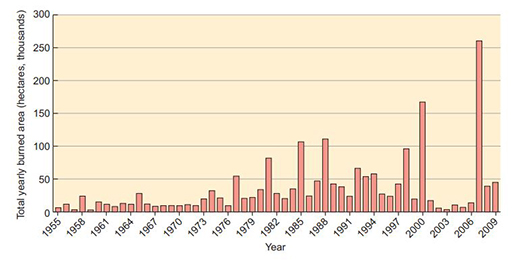2.2 Why?
The rest of this course will explore why wildfires occurred and spread in Greece in more detail. However, it is initially important to appreciate that forest fires are a serious challenge in Mediterranean Europe and some Mediterranean ecosystems are both prone to fire and dependent on it to reproduce and regenerate.
The Mediterranean climate contributes to summer fire danger because:
- wet winters produce abundant fuels, while very dry, hot summers cure those fuels to high levels of flammability (Wainwright & Thornes, 2004)
- in coastal regions during the summer months, strong winds may fan forest fires
- drought recurring on a 3–5-year time scale exacerbates normal summer season fire conditions (Morehouse et al., 353–4).
As you can see from Figure 7, the number and frequency of fire events has been increasing since the mid-1970s. Though more extreme dry summers may be a factor, evidence suggests that a complex combination of human factors, physical conditions, and ecological processes combine to produce a distinctive form of fire with particular environmental consequences. Significantly more severe than previous events, the Greek wildfires of 2007 exemplify this:
- some but not all of the Greek wildfires of 2007 were set deliberately by humans
- forms of agricultural practice exacerbated the risks
- political organisation and mismanagement undermined responses
- economic and property development opportunities provided incentives for land use change
- climatic, ecological and resourcing issues made environmental restoration difficult.
This range of factors will be explored in more detail in Section 3: Wildfires as environment-society entanglements.
Activity 2
a.
(a) 50,000 hectares of forest and agricultural land (c. equivalent to 35,000 football pitches)
b.
(b) 100,000 hectares of forest and agricultural land (c. equivalent to 70,000 football pitches)
c.
(c) 180,000 hectares of forest and agricultural land (c. equivalent to 130,000 football pitches)
The correct answer is c.
a.
(a) The Acropolis
b.
(b) Olympia
c.
(c) Delphi
The correct answer is b.
a.
(a) Dry winters produce abundant fuels, while very wet, hot summers cure those fuels to high levels of flammability.
b.
(b) Forms of agricultural practice exacerbated the risks.
c.
(c) Mediterranean ecosystems are both prone to fire and dependent on it to reproduce and regenerate.
d.
(d) The Greek wildfires of 2007 were caused by lightning strikes and other natural causes.
e.
(e) Political organisation and mismanagement undermined responses.
The correct answers are b, c and e.
Answer
Wet winters rather than dry winters produce abundant fuels, while very dry hot summers cure those fuels to high levels of flammability. The Greece wildfires of 2007 were caused by a range of human and environmental factors.

